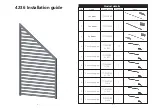
ACCQPrep HP125
Section 4 Operation
4-6
over fluid from a previous separation and fills the loop with
the initial gradient conditions from the current separation.
This prevents any strong solvent remaining in the loop
from affecting the current separation.
3. Near the end of the equilibration, the inject valve moves to
the sample load position.
4. The AutoInjector Module aspirates enough sample to fill
the loop with the programmed amount and to compensate
for the volume of the sample probe.
5. After the equilibration has completed, the injection valve
moves to the separation position and the separation pro-
cess continues.
6. After the first separation has completed, the next separa-
tion begins with the equilibration as described above (from
Step 2). During this process, the AutoInjector Module con-
tinues to aspirate the programmed injection volume.
7. When the sample is aspirated for the final injection of the
sequence, the total volume of all the sample injections will
match the programmed amount.
• If the sample container held less sample than
programmed, the final injection will aspirate a small
amount of air. Small amounts of air will not damage the
HPLC column.
• If the sample container held more sample than
programmed, there may be some sample remaining in
the probe after the final injection. For this reason, it is
recommended that users program the injection sequence
with about 0.5 mL more sample volume than the actual
sample amount provided in the sample container. This
will ensure all of your sample is processed.
• If some sample remains in the sample probe (probe
volume is approximately .43 mL), it can be recovered by
loosening the sample probe fitting at the injection valve
to allow the sample to drain back into the sample
container.
After completion of the final injection, the system washes the
sample probe to prevent sample carryover during the next sepa-
ration. To perform the wash the system will prompt you to follow
the proper wash steps.
The wash sequence is detailed as follows:
1. The system will prompt you to place the probe in a strong
wash solvent. This solvent should be capable of completely
washing the sample from the probe.
2. 10 mL of strong solvent is aspirated through the probe to
wash away any remaining sample from the probe.
3. The system will prompt you to place the probe in a weak
wash solvent.
Summary of Contents for ACCQPrep HP125
Page 2: ......
Page 6: ...ACCQPrep HP125 Installation and Operation Guide Safety Warnings 6 ...
Page 10: ...ACCQPrep HP125 Table of Contents 4 ...
Page 16: ...ACCQPrep HP125 Section 1 Introduction 1 6 ...
Page 100: ...ACCQPrep HP125 Section 5 PeakTrak 5 36 ...
Page 128: ...ACCQPrep HP125 Section 6 Maintenance 6 28 ...
Page 130: ...ACCQPrep HP125 Appendix A A 2 This page is intentionally left blank ...
Page 132: ...ACCQPrep HP125 Appendix A A 4 This page is intentionally left blank ...
Page 134: ...ACCQPrep HP125 Appendix A A 6 This page is intentionally left blank ...
Page 135: ...A 7 Appendix A ACCQPrep HP125 This page is intentionally left blank ...
Page 136: ...A 8 This page is intentionally left blank ...
Page 138: ......
Page 140: ......
Page 142: ......
















































